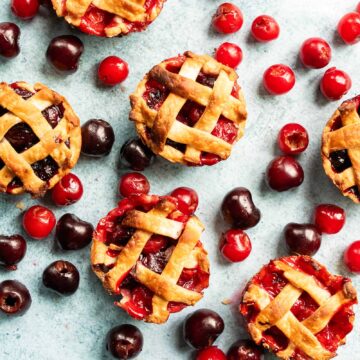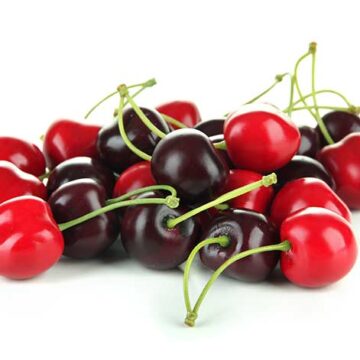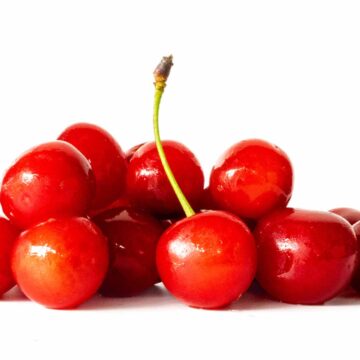There are essentially two types of maraschino cocktail cherries - the bright red, corn syrup soaked cherries or the expensive but delicious, naturally dark red, full flavored cherries by brands like Luxardo.
This recipe is for homemade, gourmet cocktail cherries without the extra additives. They are really easy to make and can be stored in the fridge or canned for later use.
When sour cherries are in season at the farmers market, get an extra quart to make your own DIY cocktail cherries at home.
Jump to:
Recipe

Equipment
- 2 1-pint jars
Ingredients
- 1 quart sour cherries
- 2 cups water
- 1-2 cups sugar
- 1 teaspoon almond extract
Instructions
PREPARE INGREDIENTS
- Pit cherries, setting aside in a bowl to collect juices.1 quart sour cherries
- If canning, bring a large pot of water to boil. Sterilize jars.
MAKE SYRUP
- Add water and sugar in a sauce pan (that is big enough to also accommodate the cherries in the next step). Heat until boiling.2 cups water, 1-2 cups sugar
- Add cherries to boiling syrup, including their juices. Simmer for a minute or two - just long enough that the cherries absorb some of the syrup. This prevents them from floating when stored.
STORAGE
- If storing in the fridge: transfer cherries & syrup to jars for storage for up to 1 month in the fridge.
- For canning: with a slotted spoon, scoop cherries out of the syrup mixture and pack into canning jars tightly, without crushing them. Ladle hot syrup over the top, leaving a ½ inch of headspace (space to the top of the jar). Cover with a lid and tighten the rim. Process in your large pot hot water bath as instructed below. (If new to canning, see rest of blog post for detailed instructions).
- Hot water bath processing times:- Elevation of 0-1000 feet: Pints for 15 minutes or quarts for 20 minutes- Elevation of 1001-3000 feet: Pints for 20 minutes, quarts for 25 minutes- Elevation of 3001-6000 feet: Pints for 20 minutes, quarts for 30 minutes- Elevation above 6,000 feet: Pints for 25 minutes, quarts for 35 minutes
Notes

Sour cherry varieties
There are two common types of sour cherries: Amarelle and Morello.
Amarelle
Amarelle cherries have bright red skin, translucent yellow flesh, clear juice, and are very tart. The most widely available variety are Montmorency. Other varieties include Meteor and Early Richmond.
Morello
Morello cherries have darker red skin, red flesh, and red juice. English Morello (often referred to as simply 'Morello') are the most common. Other varieties include Amarena, Marasca, North Star, and Balaton.
Marasca cherries are the ones made famous in the original maraschino cherries from Europe. Amarena cherries have taken off in the US as another high quality alternative.

Types of maraschino cherries
In the US, pretty much any cherry in a sugary syrup can be called a maraschino cherry, although that wasn't always the case.
What can be considered a maraschino cherry
The original name comes from Europe, referring to cherries preserved in maraschino liqueur. That liqueur is made from crushed marasca (sour) cherries. They eventually became popular in the US, but they were incredibly expensive due to the limited supply and import costs.
In order to reduce costs, several American producers worked out different ways to make maraschino cherries domestically. Sour cherries only grow well in a handful of cooler climates, so they started using sweet cherries like Queen Anne that are broadly adapted to more climates.
Soon, these alternative cherry products joined the market alongside the original maraschino cherries. To avoid confusion, the USDA required anything labeled as "maraschino cherries" to specifically be marasca cherries preserved in maraschino liquor. Those red-dyed Queen Anne cherries were then labeled as "imitation maraschino cherries."
However, in 1940 that labeling was loosened to include pretty much any type of cherry packed in any sugar-syrup, flavored with bitter almonds or something similar. That's why it seems that every cocktail cherry in the US is called a maraschino cherry.

Types of homemade cocktail cherries
There are a handful of different types of cocktail or maraschino cherries you can make at home.
- Bright red dyed version: these mimic the candy-red "maraschino" cherries (often made from Queen Anne cherries). They require soaking in a brine which draws out liquid and its color. Then infused with syrup, alcohol, and a ton of red dye. I found the brine step doesn't seem to improve the flavor or texture, at least not enough that I could notice.
- Alcohol version: soak the cherries in an alcohol-syrup mixture. The alcohol could be Luxardo maraschino liquor, rum, or bourbon.
- Non-alcohol version: simply soaking the cherries in a simple syrup, often with a dash of almond extract. Other flavors can be used, like cinnamon or anise.
This recipe is for the last version, without alcohol. I almost always make cocktail cherries alcohol-free so that they work well in drinks using any spirit. That said, I have made a smoked-bourbon cocktail cherry in the past specifically for Manhattans and it was incredible.

Finding the best cherry & methodology
First of all, my test recipes were based off of the guidelines from trusted resources in case you choose to can them. In this case, I used Penn State's guide for preserving cherries in a homemade syrup.
Next up: what's the best type of cherry to use for cocktails? I've used sweet cherries in the past and they are quite tasty. They were missing a little something though, and it turns out the tart flavor from sour cherries is what makes a really great cocktail cherry.
A vendor at my neighborhood farmers market happened to sell one of each type of sour cherry so I was able to test out both:
- Montmorency (Amarelle) - bright red skin & translucent flesh
- Balaton (Morello) - dark red skin & red flesh
I also wanted to see if soaking cherries in a brine solution made a difference and to see how it affected the color. No one wants to eat a homemade discolored cherry afterall, they'll probably think it's spoiled! I tested the following methods:
- Sugar-syrup
- Brined, then soaked in a sugar-syrup
- Brined & dyed, then soaked in a sugar-syrup

The best cocktail cherry
The best homemade cocktail cherry was the Balaton (a morella type sour cherry) that was soaked in a sugar syrup. It had the best flavor, which was sweet, tart, and complex. The hint of almond extract blended in perfectly to enhance the cherry's natural flavor.
Dye had no impact on the color, as they were already dark red. In the photos above, the color is true to real life - they naturally have a deep red color that bleeds into the sugar syrup.
Runner up
The montmorency cocktail cherries prepared with only a sugar syrup were also excellent. These tasted just slightly less complex than the balaton cocktail cherries, but were also highly rated.
They didn't need any dye as the skin's red color was enough to make a bright red syrup without any additives. In the photo above (upper right), you'll notice the color is a brighter red than the balaton cherries, but not the fake candy-red you get from using a dye.
Not recommended
Brining cherries added no value in my tests and in fact, had some negatives. The brined cherries turned an unappetizing grayish color but gained some of it back after soaking in the syrup. Dye also helped, but a lot is needed to make a big impact.
The brined cherries also tasted just slightly salty, which wasn't great. I tested these a few more times to make sure I didn't mess up the salt levels or forget to thoroughly rinse them. Each time, they still had a hint of salt. A sprinkle of sea salt may be tasty on a cookie or in caramel, it is out of place in cocktail cherries.
A natural almond flavor
Cherries and almonds are actually related. In fact, cherry pits (as well as peach pits) are used to make almond extract because they have the same flavor compounds. Maraschino liqueur has a subtle nutty flavor because it is made by including cherry pits along with the fruit.
A majority of maraschino cherry recipes include a tiny amount of almond extract to make up for this lost flavor. I've made versions with and without almond extract, and everyone prefers the cocktail cherries with a hint of almond.
The idea isn't to add a noticeable almond flavor, but to add complexity. The cherries taste less one-note, without being able to specifically taste the almond itself.
Pitting cherries
Over the years, I've probably pitted close to 10,000 cherries, thanks to some very productive cherry trees in my back yard. I have a few tips to help you along the way.
Cherry pitter tool
I use a pitting tool that fits 4 cherries at a time. This is the cherry pitter I've been using for years and it's held up this entire time, fitting both large sweet cherries and small sour cherries too.
The one I use works pretty well. It almost always gets the pits out, but I still check them to make sure. When I remove the cherries from the pitter, I squeeze them a little before tossing them in a bowl. If they still have a pit, I'll feel it as I squeeze them.
I've tried other types of cherry pitters, but haven't been happy. There are some that pit one at a time. Those are perfectly fine for small jobs. They work great for pitting olives too.
I also tried the mill-type pitters where cherries move through a funnel and then get pitted one at a time. The idea is that this is much faster (and it is), but it missed about 25% of the pits. The one I bought (and returned) has really high reviews and other people claim it pits at a much better rate - but I tried it on different types of cherries and wasn't a fan.
Browse different types of cherry pitters on amazon.
(The link to the cherry pitters is an affiliate link, so I get a tiny commission if you buy something. I only recommend products I use and like because I don't want to lose your trust or waste your money!)
Other tips
Ripe cherries actually have a lot of juice, which is bright red and acidic. This leads me to my first two tips: wear old clothes and latex gloves.
When pitting cherries, juice will inevitably end up where you don't want it. It can easily stain clothes or wood cuttingboards (which usually fade with washing over time). Wear old clothes! But if you do get a cherry juice stain, try some of these recommended methods to remove it.
The juice is also acidic, especially for sour cherries. I haven't had problems pitting sweet cherries, but I have gotten pretty dry hands and cuticles after pitting several quarts of sour cherries. I started wearing gloves now!
My last tip is related to using the cherry pitting tools. You can put the cherry in them facing any direction. The stem end doesn't have to be up. The pit is pretty centrally located from any side (like a pit in the center of a ball). They seem to pit perfectly fine whether I have them face up or on their side. This should save you time when loading your cherry pitter.
Canning cocktail cherries
I try to make cocktail cherries every summer, saving a few for gifts (like giving to party hosts). Canning them is pretty easy, and easy to do it safely.
Cherries are pretty acidic, which is essential for canning in a water bath. Water bath canning is simply submerging jars in a pot of boiling water for a set amount of time. That's it!
It works because the acid prevents bad stuff from growing, and the boiling water heats through the jars' contents to kill anything that might have already been in there.
If you are new to canning and want to understand how to do it, and do it safely, read through "How to safely can Jams, Jellies, and Preserves." The same rules apply for canning fruit in syrup, like these cocktail cherries. For more easy recipes, I recommend the Ball Book of Canning.
Equipment for canning
If you don't have any canning equipment, you can start by buying some jars, and cobbling the rest together with things you have at home. The Prairie Homestead has an article to check out, "How to can food with no special equipment."
If you're willing to spend just a little bit, however, the process can be even easier. You can use a dutch oven or deep soup pot that you already own, then get a kit (like this one from Ball) which includes:
- 9" silicon rack
- Jar lifter
- Funnel
- Bubble remover tool
- 4 pint jars with lids and rings
- A little packet of pectin for making jam
This kit costs the same, or several dollars less, than other products and it includes 4 jars. It's actually a really great value. (The kit is an affiliate link. I don't personally own this kit as it wasn't available when I bought mine a long time ago. But after some research, this is the one I would personally buy and feel confident recommending).
Most kits don't come with a rack and ones that do often have ones too large even for a dutch oven. For reference, a 6 quart dutch oven usually has about an 11" inner diameter and a lot of racks are slightly larger. I also like the silicon rack instead of metal, so that metal doesn't accidentally scratch my pot.
Other starter canning kits also have a couple of extra tools that I've personally never used (a tool to grip jars to loosen them for opening which I find clunky and unnecessary, and mini tongs that seem to have no good use that a regular tongs can't handle).
More cherry recipes & resources
Interested in other homemade maraschino cherry recipes?
- Maraschino cherries using frozen tart (sour) cherries, by Simply Scratch
- Luxardo maraschino cherry recipe by A Cozy Kitchen
- Smoked brandied cherries by Cooking 4 one (I made these before, and used bourbon)
Make the most of cherry season with any of these other recipes too. Whether you have access to sweet or sour cherries, there is a recipe for everyone.
- Cherry pie: are sweet or sour cherries best?
- Chocolate cherry tart with a rich ganache layer
- Sour cherry tart with almond cream & a french cookie crust
- 50 cherry recipes to catch your interest (cheese plates & pies to salads & steak)
- Cherries
- Tart (sour) cherries
- How to make apple butter & recipe for canning
- How to safely can jams, jellies, and preserves









Leave a Reply